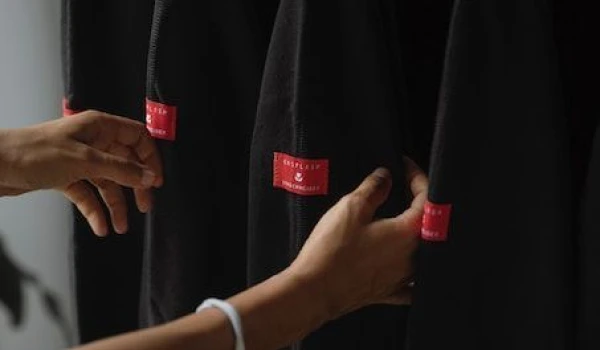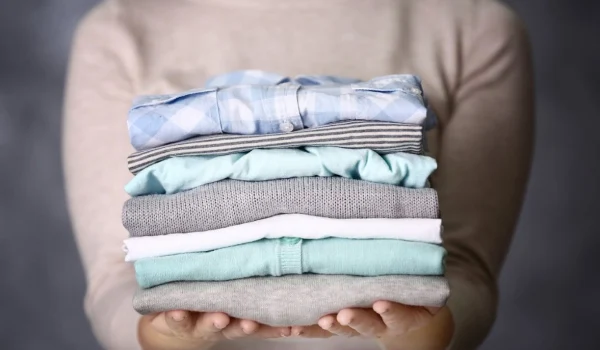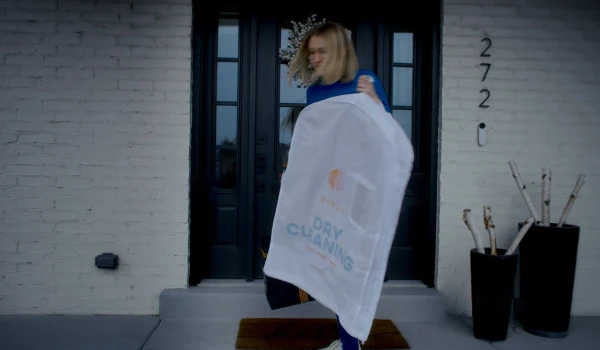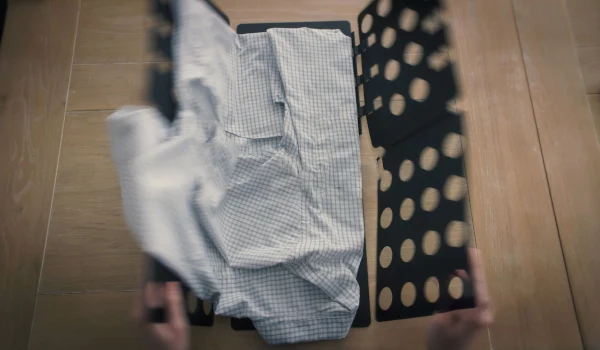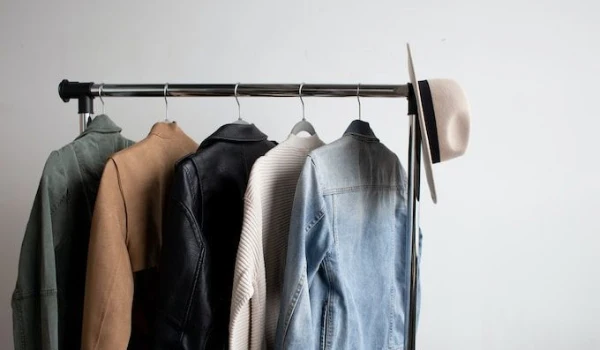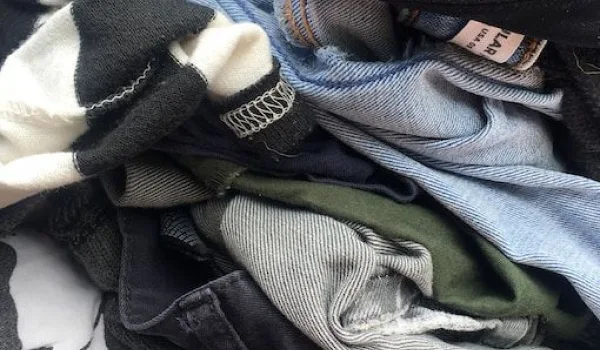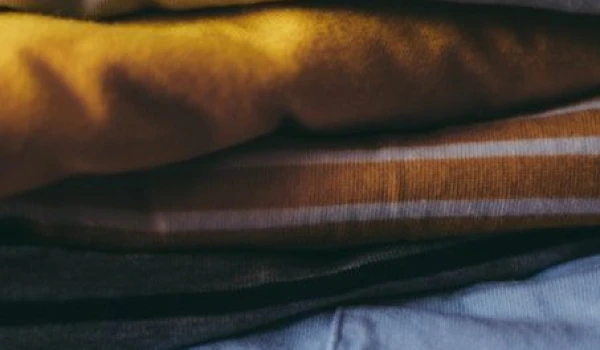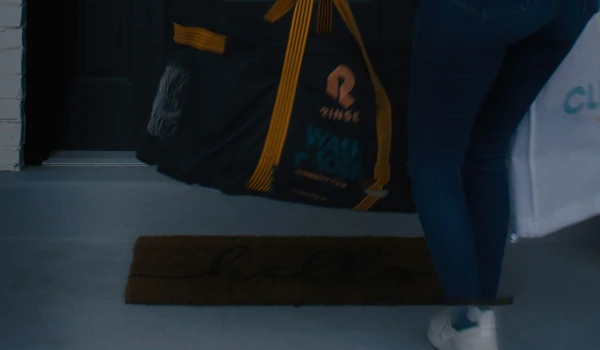Rinse
News and a look at Rinse behind the scenes

Learn how to properly use mothballs at home.
Clothing care has evolved over time as trends and technology change how we clean, preserve, and protect our garments. Mothballs have a storied past as a form of insecticide created to keep cloth-eating moths from damaging garments being stored away in drawers at home.
What Are Mothballs?
How to properly use mothballs:
1. For clothes that you do not plan to wear for a month or more, place them in a closed container like a plastic storage bin or plastic laundry bag (as close to airtight as possible). Doing this keeps the vapors from the mothballs concentrated on the intended items to eradicate insect larva.
- There is no need to use mothballs for synthetic items since insects prefer natural fibers.
2. Wear rubber gloves when handling mothballs (you’re a lot bigger than insect larva but poison is poison). Read the package to determine how many of this particular brand of mothball you should use, and place the specified amount among your clothes.
3. When you’re ready to wear your stored items again, unpack your clothes in a well-ventilated area. Air your clothes out for a couple days and then wash them according to the care label.
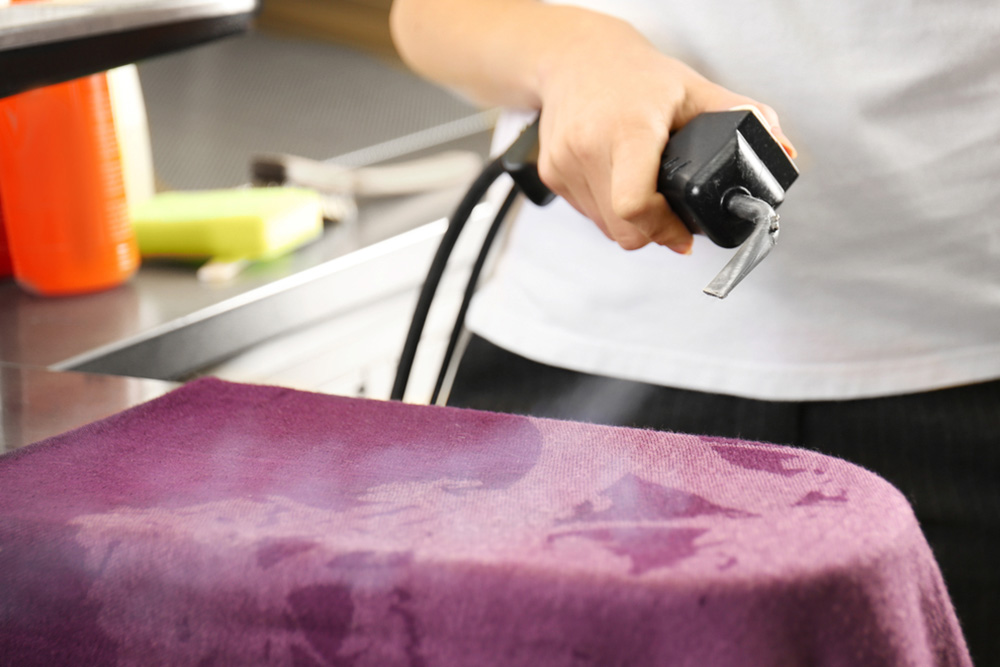
A Short History Of Mothballs
In the early 1800’s, certain chemists began to experiment with purified coal tar and the odiferous properties that characterized this white, waxy, solid substance. By 1821, a chemist named John Kidd standardized production of this chemical, which we know as naphthalene today. Soon after, the famous scientist Michael Faraday, Godfather of modern electromagnetic theory, identified the molecular formula of naphthalene, which further established its notoriety in the scientific community.
Experimentation with naphthalene continued over the next several decades, and another substance was eventually developed after it was discovered that burning naphthalene generated significantly large flames. It was through this experimentation that a second active ingredient in mothballs came to be known: paradichlorobenzene. This new substance generated a similar vapor as naphthalene, making it an effective pesticide when used in the correct conditions.
Together, these two chemicals represent the active ingredients in mothballs as we know them today, thanks to years of experimentation in the 19th century by several dedicated scientists.
Fast forward to modern times and the reliance on mothballs as a key element of clothing care and preservation has begun to fade, thanks to the proliferation of three luxuries that are easily taken for granted:
- Central heat and air conditioning
- Synthetic garment materials
- Home pest control
Thanks to central heat and air conditioning, home windows and doors can remain closed, which reduces the likelihood that moths and their cloth-eating larvae will find their way into your closet. But before HVAC systems were common, most households looked to natural air flow to regulate temperature inside, which brought with it the increased chance that pests would enjoy valuable clothing for lunch.
In addition, as the rise of synthetic materials like nylon, polyethylene, and polyester eclipse the presence of natural fibers like cotton, wool, and silk in the closet, moths are less likely to seek out clothes as a food source. Fortunately for us, moths and their larvae do not eat synthetic materials.
Finally, other methods of home pest control have outpaced the effectiveness of mothballs, which means that moths and other pests are eliminated before they even make it to the places where you store your clothing.
The phasing out of mothballs’ prominence as the last line of defense in your wardrobe may represent the final chapter in the interesting story of this smelly and sublimating substance. As we look back over the history of mothballs, one thing is clear: clothing care matters, and scientists will continue to innovate new ways to preserve and protect our garments.
If you’ve ever unfolded a sweater at the beginning of fall to find it riddled with holes from hungry moth larvae, it’s not a stretch to understand why mothballs exist.
Moths and carpet beetles love anything made of natural fibers, (think: your favorite wool sweater) because it’s a place to lay their larvae and guarantee their offspring have a hearty first meal. (They also are big fans of pet dander and hair, which is why it’s important to clean your clothes thoroughly before storing them.)
Since it’s near impossible to find and remove larvae from clothes, the most efficient and effective way to make sure your clothes are still in one piece when you unpack them is to add a few mothballs among your garments that are being stored for a month or more. The mothballs emit a poisonous vapor that kills any larvae that may have hitched a ride on your clothing, thereby eliminating the possibility of chewed fabric.
Poison, you say? Sounds risky.
Well, yes -- if you’re a moth. There is a right way and a safe way to use mothballs, so read on!

Follow the proper protocol when you donate your used clothing. Check out our recommendations below.
Donating clothes is a useful (more closet space is always welcome!) and sustainable practice. Making sure your clothes are repurposed not only reduces the amount of textile waste in landfills, but also decreases the use of resources needed to manufacture clothing: water, energy, chemicals, and fabrics. Not only that, but charities can help communities in need.
The Do's: How To Sort Through Your Clothes
- Is anything collecting dust in your closet or at the bottom of your drawer? Consider donating clothes you simply don’t wear anymore.
- Too small or tight? It’s time to pass it down to someone else.
- No longer going through “that phase”? Get rid of anything that doesn’t fit your style.
- Don’t be afraid to include high-end items like a suit or formal dress. Many donation centers will take those items aside for special programs and charities that help people in need look sharp for a job interview or events like prom.
Clothing Donation Don'ts
- No undergarments. No, if’s, and’s, or but’s about it. Undies are items that need to be bought new, no matter how cute your old ones are.
- Does your old favorite shirt have a hole in it? Then it’s time to repurpose, recycle, or throw it away. Only consider donating items that are like-new or gently worn.
- Do your shorts still have a weird smell? That’s a no for us dawg.
- If any of your clothes have spots or stains on them, try to remove them yourself or take them to a professional. If the stain won’t budge, then sadly the item should not be donated and instead repurposed.

Make Sure All Items Have Been Recently Washed/Dry Cleaned
You want your clothing donations to be fresh and clean for their new owner. Rinse can help here — we can come pick up your clothing donation, wash it, and then take care of donating it!
Where To Donate Clothes
This one may seem pretty obvious but without a plan, chances are your bag of donations may end up sitting in the garage or closet for another six months. To make things simple, here are two options to get those items out the door!
- Option 1 - Rinse will pick up your clothing donations, free of charge with any Rinse order. You can check if you’re in our service area here.
- Option 2 - Drop your clothes off at a local charity. Here are some national and local organizations that accept clothing donations:
- American Red Cross
- Becca's Closet
- Big Brother Big Sister Foundation
- Goodwill
- Your local place of worship
Clothing Donation Alternatives
If your clothes are too far past their prime to be donated, don’t despair, you can also repurpose or recycle them and minimize your environmental footprint.
Repurpose old clothes:
Some old clothes can become dust rags used for cleaning while other types of clothes like shirts can easily be turned into dog toys. (Here is a great how-to video for cutting up old shirts and braiding them into chew toys — It’s a fun project for kids and if you create too many, local animal shelters often welcome toys of any kind to keep their pups entertained.)
Recycle clothes, towels, and bed sheets that aren't fit for donation:
If you can’t find any way to use your old clothes around the house you can always reach out to local nonprofits about helping you with textile recycling. Oftentimes, they may be able to facilitate taking your old clothes to textile recyclers. If you need a jumpstart looking into recycling options check out Secondary Materials and Recycled Textiles (“SMART”).

Does it cost more to clean men's shirts vs. women's shirts? We discuss the gender bias present in the clothing care industry.
Just like any other industry, clothing care is not immune to the politics of dress. Gender still plays a subtle role in the cost of treating each garment, and women usually end up paying more—a practice widely referred to as "pink tax." Just as a pink razor will often cost more than a blue one, women's button down shirts cost more to be cleaned at the dry cleaners than men's button down shirts.
But why does this happen? And, more importantly, will it ever change? We take a look at the reality of gender bias in the clothing care industry and how consumers can use their purchasing patterns to make a difference.
Gender bias: It's not what it seems

In contrast to its application to many consumer products, gender bias in the dry cleaning business is not an intentional creation (at least, not directly). While products such as razors and shampoo are intentionally marketed to women at inflated prices (though they are nearly identical to their male-focused counterparts), it's actually the infrastructure surrounding dry cleaning practices that has informed the disparate pricing model.
The machines that dry cleaners use to press button down shirts are sized to fit men's shirts, and since women's shirts tend to be smaller than men’s and cannot fit onto the machine, they need to be hand-pressed. Most dry cleaners have not invested in a machine customized for women’s shirts because they're very expensive, and men tend to dry clean shirts more often than women.
In short, women's shirts actually cost more to clean, hence the higher price tag. In fact, dry cleaners who charge the same for men's and women's button down shirts may actually operate at a loss to provide this service.
Beyond the button down

When thinking about gender bias in clothing care, it's important to note the difference between a button down shirt and a blouse. Most cleaners will charge more for the latter, and rightfully so, as it's a different type of clothing that requires a more delicate touch. Blouses tend to be more intricate and must be pressed by hand to avoid damage to any details, embellishments or delicate materials such as silk or lace. On the other hand, button down shirts have a flat front that can easily be pressed by a machine (as long as they fit).
But beyond the button down, gender-based pricing can also extend to other garments such as dress pants or even casual wear like denim. Although no federal law has been passed, some states—namely New York, Florida and California—have acted locally by prohibiting gender pricing in some industries. Until more states follow suit, the fairest companies will consider changing their policies to charge the same price for similar pieces.
A call to consumers

Consumers sometimes underestimate their role in creating real change within any given industry. Savvy customers research and choose smart companies that do their part to deal with discrepancies such as these. If companies see that their customers are demanding standardized price points for similar items, they'll be motivated to address the issue of gender bias in clothing care.
The notion of "voting with your wallet" (making sure that your purchasing patterns are aligned with your values) is often associated with consumers' retail purchasing decisions. Should they spend the extra money to ensure every component of what they're buying is ethically sourced and created? More importantly, will this process actually change anything? The short answers to these questions: yes, and, we hope so.
This concept is just as important, maybe even more so, in service industries that see issues of inequality. Thankfully, some companies are making this an easy fix for consumers by providing services at the same cost.
While companies may have to operate at a loss if they charge the same price for men's and women's button down shirts, for responsible businesses, the issue of gendered pricing goes beyond the bottom line. Luckily for the consumer, it doesn't always have to.
Photos: WorldWide / Shutterstock.com, Olu Eletu, Benjamin Child, Samuel Zeller

Everyone needs socks! Most people nowadays are excited to get socks as a gift - find out why!
You may recall being a child anxiously waiting for the holidays to arrive. You might have been hoping for that new toy, video game system, or whatever the latest and greatest item was that year, only to wake up and tear open a sweater or worse, a pair of boring socks. Why on Earth would anyone gift socks? That’s a fair question to ask especially when you were younger, but we could argue that receiving socks is a great thing. Don’t believe us? Here’s why!
So Many Choices

The days of plain white socks are gone. There are endless options ranging in color, size, design, and even socks for you pop culture junkies. Socks now feature your favorite movie characters, musicians, food, and emojis. There are plenty of options to choose from!
Economical
Unless you are planning a big surprise (hint: wedding bells) or plan on breaking the bank on some designer wear you can’t go wrong with socks from a price standpoint. Stores typically offer a better price point the more you buy and be on the lookout for a buy one get one sale.
Sensible
If there is one given with clothing it is that everyone needs socks (and underwear). At some point towards the end of your own laundry cycle, you may struggle to find clean socks. Having an extra pair or two while you wait for your Rinse order to be returned to you isn’t necessarily a bad thing. And given that we wear socks almost daily, it is always good to replace some of your older and more beat up pairs.
Effortless Packaging
Grab some tissue paper, a holiday gift bag, or wrapping paper if needed. Either way, socks are easy to wrap for those of you who are not particularly great at wrapping gifts.
Make It A Tradition
Now that socks are an outlet for expression, start a new tradition by gifting someone some crazy socks or make them a fun add-on to your main gift. Try to top yourself each year by finding a new outlandish design. They will always be practical!
Happy Holidays and Happy Rinsing!
Photos: Fresh Connection on Unsplash / Les Triconautes on Unsplash

Let’s face it, “business casual” is a perplexing term that can be interpreted in many ways. You might get away with an open-collared shirt and jeans in one office, while in another workplace you might be expected to show up wearing a tie or a skirt.
While “business formal” usually refers to a suit and tie for men, and dress pants with a matching jacket for women, “business casual” is its less buttoned-up cousin. You have some freedom to inject your own unique style into your outfit with accessories and atypical silhouettes, while maintaining a stylish and professional appearance.
So what does that really mean? Whether you work in a creative or corporate office, we solve this vague dress code once and for all. Here’s our guide to dressing “business casual.”
Tops: button-down shirts and blouses

Women: A “business casual” top can be a silk blouse or a crisp button-down shirt. At a creative company, play with silhouettes like bell sleeves or ruffles. You can add some tasteful flair by accessorizing with a dressy belt or statement necklace.
Men: A tailored button-down shirt in solid colors or subtle plaids is a polished look. Show off your layering skills with an unstructured sports jacket or half-zip sweater.
Care tip: Ink stains can strike when you least expect them. Blot the stain with some rubbing alcohol—which works on most fabrics—and place a paper towel over it to absorb the liquid. (Avoid using club soda, which can set ink stains.) While a professional is most equipped to clean silks, you can toss cotton shirts in the washing machine using cold water, and then hang them to dry.
Bottoms: dress pants and chinos
Women: Choose dressy work pants that have enough room to tuck in your top. For dresses and skirts, ensure hemlines fall no more than 1” above the knee, and stay away from casual fabrics like jersey or linen.
Men: Dress pants or chinos are your go-to options. Keep them well-pressed with a steamer to maintain a professional appearance.
Both: Dark denim works in casual offices, but make sure there are no tears, rips or distressed patterns. Ladies can opt for sophisticated cuts like wide leg trousers or skinny jeans, while men can go for modern straight/slim-fit styles.
Care tip: If you find yourself wearing your lunch, use a mix of soap and water to get as much of the stain out as possible. Once you’re back home, pre-treat with a stain removal stick and launder according to the
Shoes: classic pumps and leather loafers

Women: Slip into ballet flats or classic pumps with a heel no more than 3” high. In less formal offices, suede or leather ankle boots are a fashion-forward yet professional option.
Men: Sleek leather loafers are a great choice, but you can have some fun with hybrid dressy-casual leather sneakers in a creative work environment.
Both: Leave the flip flops and athletic shoes at home, unless you ever find yourself working outdoors.
Care tip: To keep your leather shoes looking their best, wipe any dirt off with a soft damp cloth and gentle soap. Follow up with shoe polish to buff your footwear back to their shiny glory. For suede, use a suede brush to scrub away any blemishes. Refer to our leather guide for more tips on caring for leather footwear.
General tips for dressing business casual

“Business casual” can be confusing, but you can follow these general guidelines to avoid an awkward office fashion situation.
- The type of office you work in and the nature of the workday are important clues to deciphering this dress code. Corporate settings may be restricted to dress pants while startups and creative companies may allow for jeans.
- How your fellow colleagues dress for work will also give you some insight. For example, they may be dressed to the nines for client meetings, but for regular workdays they might show up in casual yet polished ensembles.
- It’s better to play it safe and go for something more formal, not less (so no sweatpants, please). If you’re really in doubt, it never hurts to ask your boss to define your workplace’s version of “business casual.”
Now that you have a better understanding of this perplexing dress code, you can start putting together work outfits that will impress your coworkers and clients. Knock ‘em dead. You can also get business casual looks delivered to your door by scheduling a Rinse laundry or dry-cleaning pickup.
Photos: Syda Productions / Shutterstock.com, Unsplash, Vladeep / Shutterstock.com, Alexander Andrews, Aila Images / Shutterstock.com
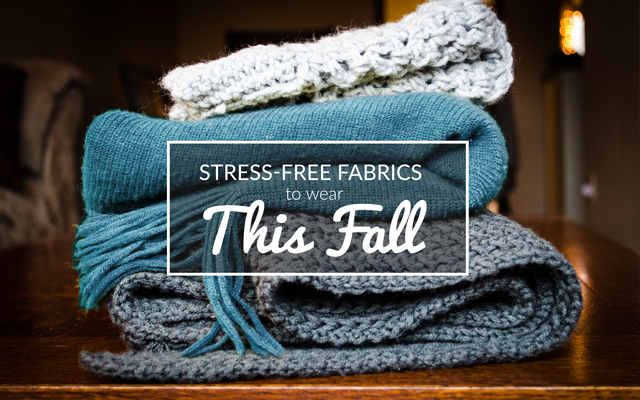
While looking our best and staying warm may be our top priorities as the weather gets chillier, we also want to make sure that we're well prepared to take care of our wardrobes in the coming months. Stay effortlessly layered with these comfortable fabrics for a season of changing colors and cooling temperatures.
Knitwear

Few things say fall quite like curling up with a big cup of coffee in your favorite oversized knit. To keep your favorite cuddle buddy in great shape, place your knitwear item into a mesh laundry bag before cleaning, and use the delicate cycle. If you're washing by hand, use warm water mixed with a gentle detergent. Press or squeeze to remove excess water—wringing will stretch the material—and lay flat or hang to dry, depending on specific instructions, to maintain its shape so you can keep wearing that cozy top all season long.
Leather

This sleek, durable material works well for a lot of looks. Dress it up with a pencil skirt for work, or keep it casual with ripped jeans on the weekend. To keep your leather apparel in top condition, entrust it to a specialty cleaner—they can maintain the natural oils in the fabric, while protecting against color changes or cracks. In between professional washings, there are a few things you can do to prolong the lifespan of your leather:
- Ask your cleaner for advice on an appropriate leather conditioner.
- Hang leather pieces on wide wooden, plastic or padded hangers, in order to maintain shape.
- Keep leather out of hot or damp areas.
- Avoid prolonged exposure to direct sunlight, and don’t cover it in plastic—all of these factors can cause your leather to dry out.
- If stains do arise, blot them out with a wet cloth.
Denim

Jeans are an uncomplicated style staple that look good on almost everyone, but consider a distressed jacket for a different twist on denim—and an on-trend ode to the 90s. On that note, take a cue from street style bloggers and pair denim on denim in different shades. While this is a sturdy fabric, you should avoid machine washing because denim can shrink and fade. Most denim can be washed in cold water with mild detergent and hung to dry, but some brands would benefit from dry cleaning, and raw denim is better left unwashed.
Corduroy

For occasions when you want to give your leather jacket a break, reach for a corduroy coat to channel a style that's equal parts polished and preppy. Look for quality details such as brass buttons, which can elevate the look of standard corduroy clothing. This versatile fabric is easy to care for. It can be machine washed in warm water (for lighter hues) or cold water (for darker hues). Remember to turn it inside out before tossing the item in the machine to avoid collecting lint on the material. A quick spin on the normal cycle—tumble dry low between wears—and you're good to go.
Flannel

A fall classic, flannel is perfect for scarves, shirts, outerwear, or even a poncho—a comfortable transitional piece when the outside temperature doesn't quite call for a winter coat. Check the clothing label for the most optimal cleaning options. Most basic flannel pieces can be hand washed with a gentle laundry soap and hung to dry, while other items (such as scarves or coats) may require dry cleaning.
Wool

When the fall season gets especially chilly, you can don a wool coat, hat or sweater to stay warm. Most wool can be hand washed, but follow the label's instructions for specific guidelines. Sweaters should be swished and soaked inside-out in lukewarm water for at least ten minutes. When drying, squeeze out excess water before laying the garment flat on a mesh rack. Don’t wring out or hang your wool as it stretches easily.
With these clothing care tips, you can stay stylish all season long in the cozy textures of fall.
Photos: Maria Shanina, Llywelyn Nys, John Mark Arnold, Priscilla Westra, Luke Pamer, Benjamin Combs, Ben Blennerhassett
Topics
Rinse Drop
We offer pickup and delivery if you can’t be present between 8pm and 10pm.
Our Valet will pick up or deliver your order to your doorstep or concierge, at which point you’ll receive a text with a photo showing where your items were left.
You can enable Rinse Drop on any (or all) of your orders.
Rush Delivery
We offer Next-Day Rush Delivery for Wash & Fold orders for an additional fee of $9.95.
Simply let your Valet know upon your pickup. There’s also an option to set a permanent preference for Rush Delivery in your My Account page.




